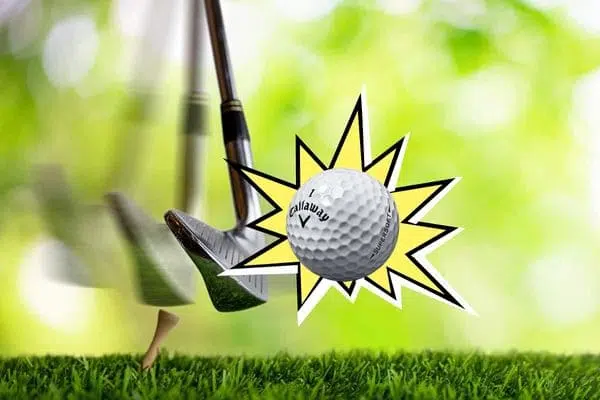Golf ball compression is a bit of a ‘goldilocks’ situation: play a ball that compresses too much and you’ll probably lose distance, yet play one that doesn’t compress enough and you’ll probably lose distance as well.
But finding the ball that is ‘just right’ to suit your swing speed can be a big factor in you gaining or losing 10 yards, as well as some other outcomes for your swing.
Which brings us to the important question: does golf ball compression matter?
Yes, golf ball compression does matter, with harder balls generally suited to players with faster swing speeds and softer balls optimum for golfers who swing slower. Matching the correct ball compression with your natural swing speed will help improve your overall performance on the course.
Golf balls have a rating that indicates the level of compression – closely linked to how soft or hard it is – you can expect when gaming it.
A rating of 30 is considered extremely soft, while 120 is extra hard.
For example, Titleist’s Pro V1 has a compression rating of about 90, whereas the Pro V1x is rated at 100.
Compare this to Callaway’s super soft balls at a rating of 38 and you can begin to understand the significant variance in designs from the top manufacturers.
That being said, many tests have shown that compression of a Titleist Pro V1 golf ball doesn’t actually vary a whole lot at speed differentials of up to 50mph.
Ultimately, it is worth going for a harder ball if you swing fast, but for players who like a softer feel, there is nothing wrong with gaming a ball that has a lower compression rating.
Table of contents
What does it mean to compress a golf ball?
Compressing a golf ball means to squeeze the ball into a flatter shape through impact, causing it to bulge out at the equator. This occurs due to the force of a golf swing placing stress on the ball, leading to distortion as a result of a large amount of energy being transferred into the ball. The right amount of compression can lead to optimum power and ball flight.
When people talk about compression, they’re usually talking about irons, rather than driver, even though your driver will compress the ball a great deal too.
Perhaps the reason compressing your irons gets a lot more attention is due to the desire from golfers out there to get that ‘sizzling’ sound that the pros do, which comes about from a perfectly compressed golf shot.
With irons, compression refers to the same thing as with driver, the distortion or ‘squeezing’ of the ball through impact, but comes about in a different way with the clubface and the ground causing the sandwich that clenches down on the ball.

How do you compress a golf ball?
To compress a golf ball you must perfect your attack angle and strike the ball with a descending blow. This will help to catch ball first, then turf, squeezing the ball between the ground and clubface to store elastic energy in the ball. Ensuring you use a delofted club and shift your weight forward prior to impact will promote the perfect attack angle to create ball compression.
The thing to be careful of here is sliding in order to get your weight going forward, as this is the misconception many golfers have about how to effectively hit down.
While you do need to get your weight moving forward to hit down on the ball, think of your belt buckle moving forward towards the target through rotation, rather than your lead hip.
You also want to feel as if the palms of your hands drive down towards the ground, rather than cupping upwards or flipping, as this will only lead to a ‘picking’ golf swing that sweeps the ball up off the surface of the ground.
It can take some time – and a few chunked shots through practice sessions – to commit to a downward strike, but once you pair it with the right dynamic loft, hitting down on the ball will make it go up in a far more satisfying and spectacular way.
Golf ball compression vs swing speed: how are they linked?
Ball compression and swing speed are closely related, with your swing speed being a good indicator of the type of ball you should use and its compression rating. If you swing the club quite fast but use a softer ball (that compresses too much), then you might find a reduction in distance.
Use a ball that’s too hard for your swing speed, and a lack of compression won’t create the energy desired through stressing the ball itself through impact, also reducing distance.
However, the relationship between these two factors may be a little exaggerated by many commentators and golfing pros out there, as trials by Titleist with their Pro V1 golf ball have shown that compression looks fairly similar at largely varying ball speeds in the video below.
The only way to truly understand the relationship between golf ball compression and performance is by testing a few differing balls and identifying the difference for yourself.
A good starting point could be testing the Titleist Pro V1x with a 110-compression rating against a Callaway Chrome Soft ball with a 75 rating.
If the Pro V1x leads to less distance than the Chrome Soft, then it’s an indication that you probably swing too slow to use this ball, failing to ‘deform’ the ball enough to get the required energy transfer creating compression through impact leads to.
Distance aside, the advantage of a softer, greater compression golf ball – like the Callaway Supersoft – can be improved spin rate at slower swing speeds.
Professional golfers are able to use harder balls as they swing so fast, leading to a high spin rate the amateur golfer would struggle to replicate.
Softer balls that compress more easily will lead to greater spin rates at slower swing speeds, something worth exploring if you generate a swing speed akin to the mere mortal golfer usually gracing the fairways of your local club.
What compression golf ball should I use?
You should use a golf ball with a compression rating that matches your swing speed. Generally, golfers who swing the club fast should use a high compression golf ball, whereas those who swing it slower should use a low compression golf ball.
Despite this, some players feel more comfortable using a ball that ‘technically’ shouldn’t suit their swing, but feels more appropriate and gives them the desired result.
The compression of the golf ball you use is likely going to be more of a feel factor than a pure numbers or rating factor, so trialing low compression balls like the Srixon Soft Feel and high compression balls like the Titleist Pro V1x is the only way to really identify which one you like best.
Spin rate is also important to consider – not just distance – as a golfer who swings the club fast but hits the ball low could actually benefit from a low compression, softer ball as they will spin it more and could add additional height to a low swing.
Do softer golf balls travel farther?
A softer golf ball with a low compression rating will only travel farther than a harder, high compression ball if you swing the club slower. Ideally, you want to match your swing speed up with adequate golf ball compression, and faster swinging players will see greater distance with high compression balls, not softer, low compression balls.
It can be a little hard to follow at times, with softer golf balls being referred to as lower compression despite the fact they will ‘squeeze’ more easily at impact.
This is perhaps because it takes a lower amount of force to compress them, given they are softer in nature.
This means that golfers who swing the club more slowly are able to stretch and stress low compression golf balls more than they would a higher compression golf ball, creating a greater amount of elastic energy, released when the ball flies off of the club face.
When you compare this to a fast swinging golfer, the harder, high compression golf ball is actually better, as a high swing speed will be able to impart a lot of compressing force onto the golf ball.
As it takes more energy to stress these harder balls, when they can be compressed, more elastic energy is stored, leading to greater ball speed and distance off the club when said energy is released.
What compression golf ball should a high handicapper use?
Generally, higher handicappers are probably going to swing the club slower, and hence should use a softer, lower compression golf ball. A golf ball that carries a compression rating of 70 or less is probably a good fit, however, if you are a high handicapper but still swing the club fast, then a high compression golf ball will still perform better, despite your handicap.
A lot of the lower compression balls on the market, such as the Callaway Super Soft and the TaylorMade Soft Response, not only suit slower swings, but come in at a cheaper price tag, which probably another beneficial factor for higher handicappers who lose a lot of balls.
If you want something that isn’t too soft – as your swing might be fairly quick – but also doesn’t reach the lofty price of a ball like the TaylorMade TP5, then Callaway’s Chrome Soft balls are generally a happy medium and something I have enjoyed playing for several years.
What is the compression of a Pro V1 golf ball?
Pro V1 golf balls carry a compression rating of around 100, with Pro V1x golf balls approaching a compression rating of 110. Generally, golfers who are looking for more distance should go for the Pro V1x in order to keep spin rate down, but really should only be pairing this golf ball with a faster swing speed.
Unfortunately, for a lot of golfers, the make up, compression rating and suitability of a golf ball doesn’t necessarily factor into their thinking, with lots of amateur golfers automatically reaching for the Pro V1s despite having a rather slow swing speed.
While Pro V1 golf balls are certainly some of the best in the game, people who don’t swing the club very fast will actually find they travel shorter than a softer golf ball.
Given that softer balls such as Callaway’s Chrome Soft balls are also cheaper, it might be worth giving these a crack before launching straight into a Pro V1 from Titleist.
Final message
While there are by no means set rules that determine what compression rated golf ball a player should use, pairing a compression rating or ‘softness’ with your swing speed is probably a good place to start.
From here, experiment with a few different brands and models until the feeling is right and you’ll be compressing the ball beautifully and be the envy of your playing partners in no time.


